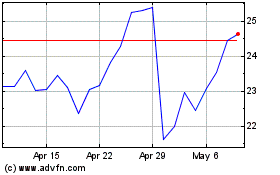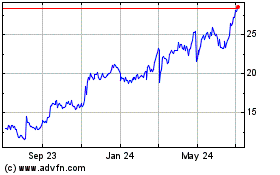Some Relief, But For-Profit Colleges Still Face Challenges
June 09 2011 - 1:46PM
Dow Jones News
Investors in for-profit colleges breathed a collective sigh of
relief last week when the U.S. Department of Education released a
softer-than-expected regulation addressing concerns about student
loan rates.
But the schools aren't out of the woods yet. They still face the
looming expiration of an allowance to get more revenue from federal
student aid sources. Continued pressure to improve admissions
standards and graduation and loan-repayment rates are also expected
to hurt earnings for some time to come.
Last week, the Department of Education issued the final version
of its so-called "gainful employment" rule, intended to ensure
vocational programs actually prepare students for jobs. Programs
could lose eligibility for federal financial aid if their students'
debt burdens prove too high. Shares of the schools, including
Education Management Corp. (EDMC), Strayer Education Inc. (STRA)
and Corinthian Colleges Inc. (COCO), moved sharply higher the day
the rule was released, as they stand less chance of losing access
to the funds.
Still, the stocks remain well below their 52-week highs. Given
the continued pressures, some say multiples may not return any time
soon.
The next major test for the industry will come on July 1, when a
hard ceiling on how much of their revenue the schools can derive
from Title IV federal aid--90%--is reinstituted. When federal loan
limits were increased in 2008, Congress provided an exemption that
allowed them not to count that additional money toward the 90%.
Sen. Tom Harkin (D., Iowa), who heads the Senate Committee on
Health, Education, Labor and Pensions, is in favor of letting the
exemption expire and is angling to count military-education
benefits toward the 90% in future calculations. Schools are
lobbying hard for an extension.
"It's tough to see how the stalemate breaks," said Jarrel Price,
an analyst at Height Analytics in Washington, D.C. If it does,
though, "the question is what the industry will have to give up to
get that relief."
Schools that rely significantly on Title IV funding and
military-funded aid--including Corinthian, American Public
Education Inc. (APEI), Bridgepoint Education Inc. (BPI), Apollo
Group Inc. (APOL) and Washington Post Co.'s (WPO) Kaplan--stand to
suffer most, Price said.
The Education Department will begin an experiment soon allowing
schools to limit the federal aid their students accept, but it will
be "nowhere near large enough to have an effect on one of these big
schools' bottom-line 90/10 ratio," said Deputy Undersecretary James
Kvaal.
Meanwhile, schools could lose access to other federal aid
through no action of their own. The fiscal 2012 budget may include
cuts to the under-funded Pell Grant program, reserved for the
neediest students. The Obama administration has fought hard to keep
the maximum grant at $5,550, but some in Congress expect the limit
to be lowered.
Corinthian derived nearly 29% of revenue from Pell grants in the
2009-2010 year, while Bridgepoint brought in 27.5% of its revenue
from that source, according to Price. Lincoln Educational Services
Inc. (LINC), Universal Technical Institutes Inc. (UTI), Kaplan and
Apollo also rely heavily on Pell funds.
Even if student funding is kept intact, the number of students
enrolling is declining. For-profit colleges have reported falling
new-student start rates as the schools tighten admissions standards
to comply with additional Department of Education rules.
Schools can expect more oversight by accrediting agencies, too,
after those groups were criticized for shirking their
responsibilities. An accreditation oversight group is expected to
issue a series of recommendations later this year.
Also, attorneys general in Florida, Kentucky, New York,
Massachusetts and elsewhere have launched investigations into the
business practices at campuses operated by companies including
Washington Post, Apollo Group and Corinthian Colleges.
-By Melissa Korn, Dow Jones Newswires; 212-416-2271;
melissa.korn@dowjones.com
CECO Environmental (NASDAQ:CECO)
Historical Stock Chart
From Mar 2024 to Apr 2024

CECO Environmental (NASDAQ:CECO)
Historical Stock Chart
From Apr 2023 to Apr 2024
